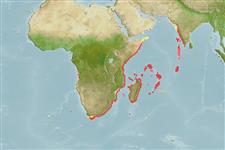>
Perciformes/Serranoidei (Groupers) >
Anthiadidae (Fairy basslets or Streamer basses)
Etymology: Meganthias: Name from Greek 'megas' for large and 'anthias' for Mediterranean fish, refers to the size of the 2 species, larger than species of Odontanthias which do not exceed 20.4 cm SL..
More on author: Fowler.
Environment: milieu / climate zone / depth range / distribution range
Écologie
marin benthopélagique; profondeur 88 - 219 m (Ref. 120660). Tropical
Western Indian Ocean: records only from the Socotra Archipelago, Kenya, Mauritius, Reunion, Seychelles, Madagascar, Mozambique, and South Africa.
Taille / Poids / Âge
Maturity: Lm ? range ? - ? cm
Max length : 37.4 cm SL mâle / non sexé; (Ref. 36345)
Épines dorsales (Total): 10; Rayons mous dorsaux (Total): 17-19; Épines anales 3; Rayons mous anaux: 8 - 9
Occurs in moderately deep waters, on rocky substrata on steep slopes (Ref. 120660). Piscivore (Ref. 97629).
Life cycle and mating behavior
Maturité | Reproduction | Frai | Œufs | Fécondité | Larves
Heemstra, P.C. and J.E. Randall, 1986. Serranidae. p. 509-537. In M.M. Smith and P.C. Heemstra (eds.) Smiths' sea fishes. Springer-Verlag, Berlin. (Ref. 4319)
Statut dans la liste rouge de l'IUCN (Ref. 130435)
Menace pour l'homme
Harmless
Utilisations par l'homme
Pêcheries: intérêt commercial mineur
Plus d'informations
PaysZones FAOÉcosystèmesOccurrencesIntroductionsStocksÉcologieRégime alimentaireÉléments du régime alimentaireConsommation alimentaireRation
Noms communsSynonymesMétabolismePrédateursÉcotoxicologieReproductionMaturitéFraiRassemblement de ponteFéconditéŒufsDéveloppement de l'œuf
RéférencesAquacultureProfil d'aquacultureSouchesGénétiqueElectrophoresesHéritabilitéPathologiesTraitementNutrientsMass conversion
CollaborateursImagesStamps, Coins Misc.SonsCiguateraVitesseType de nageSurface branchialeOtolithesCerveauxVision
Outils
Articles particuliers
Télécharger en XML
Sources Internet
Estimates based on models
Preferred temperature (Ref.
123201): 17 - 22.2, mean 19 °C (based on 21 cells).
Phylogenetic diversity index (Ref.
82804): PD
50 = 0.5625 [Uniqueness, from 0.5 = low to 2.0 = high].
Niveau trophique (Ref.
69278): 3.7 ±0.5 se; based on size and trophs of closest relatives
Résilience (Ref.
120179): Milieu, temps minimum de doublement de population : 1,4 à 4,4 années (Preliminary K or Fecundity.).
Fishing Vulnerability (Ref.
59153): Moderate vulnerability (36 of 100).
